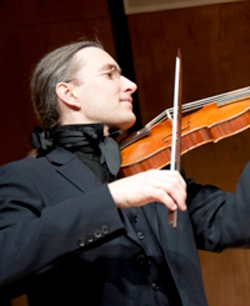by Christine Jay

Keep calm and play Bach.
Both friends and lovers of Bach, Wilkins and Brault devised a program of their favorite repertoire — teeming with the usual hyper-caffeinated Vivaldi and fervent complexity of Bach — for a program entitled “Vivaldi and Bach: Inspired Connection” with the Akron Symphony on January 16, 2016 at 8:00 pm in the E.J. Thomas Performing Arts Hall.
Skyping from Luxembourg, the engaging violinist provided an excellent commentary on the two composers, describing why such a program is both exciting and illuminating. “The beauty of Vivaldi’s music is the writing. The lines breathe together.” He went on to say that Bach’s musical language, on the other hand, shines in its contrapuntal structure. Saturday’s program juxtaposes both composers’ distinct styles and also compares Bach’s emulation and Vivaldi’s “natural beauty,” especially during their double concertos in a minor.
Brault, an esteemed practitioner of historical performance, is also committed to formulating convincing concert experiences. Several decisions arise when baroque and modern performance practices intermingle, namely challenges related to pitch and historical instrumentation.
In regards to pitch, Brault is certainly in favor of A=440 Hz, modern pitch, for Vivaldi. Brault also favors a high pitch for Bach; he mentioned some church organs in northern Germany were tuned as high as A=500 Hz! The program will be played at modern pitch, a boon for players as well as for audience members with perfect pitch.
Instrumentation is also a compelling question since Brault plays with a baroque violin and “gut” strings, while Akron Symphony members, including soloists, will play on modern instruments with steel strings. During the 2014 Four Seasons concert, Brault specifically played his highly resonant baroque violin for the historical, surround-sound resonance it emits. However, this concert will feature many double and triple concerti with other modern instruments.
For a cohesive ensemble sound, Brault will perform on his primary baroque violin with “gut” strings and will also use his modern violin. For pieces such as the Vivaldi C Minor concerto, Brault will play his baroque violin since he will have a greater number of solo passages. When playing alongside soloists with modern instruments, Brault will switch to better match the timbre of his colleagues. Brault will lead from the violin during the solo concerti and Wilkins will conduct when other soloists join the fray.
If this sounds like a snoozer, think again. As Brault said, “The way we’re going to perform this concert will be anything but boring.” In bringing together the Akron Symphony with one of the driving forces in Apollo’s Fire, Wilkins and Brault will coalesce to perform some of their favorite music for Northeast Ohio.
“I’m expecting a lot of fun,” Brault says. So are we.

Published on ClevelandClassical.com January 11, 2016.
Click here for a printable copy of this article




